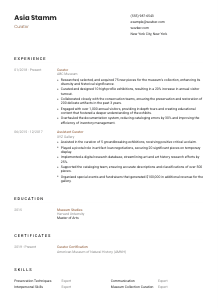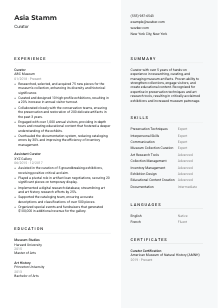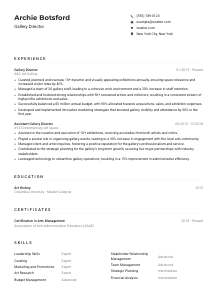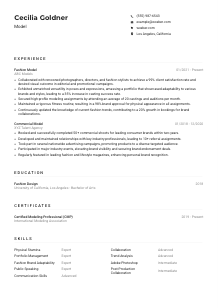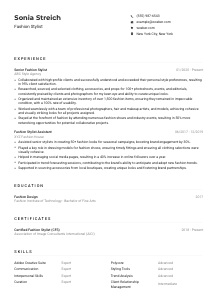Curator Resume Example
Weaving art tales, but your resume feels like a hidden exhibit? Immerse yourself in this Curator resume example, enlivened with Wozber free resume builder. It shows you how to arrange your curation narrative to align with job demands, ensuring your career stands as resplendent as the pieces you present!
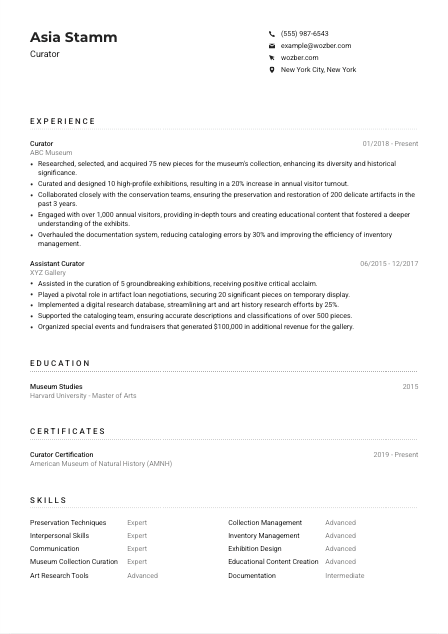
How to write a Curator Resume?
Embarking on the journey to captivate the next great museum with your expertise? The curator role is a prestigious and deeply fulfilling path, blending the love of art with the science of preservation. Crafting a resume that mirrors your passion and aligns precisely with the curator role you're eyeing is crucial. Leveraging Wozber's free resume builder, this guide is sculpted to help you navigate the nuances of creating an ATS-compliant resume that is a testament to your expertise.
Ready to unlock the doors to your next curator role? Let's dive into shaping your career narrative into an irresistible masterpiece!
Personal Details
The Personal Details section of your resume is like the foyer of a museum exhibit - it sets the stage for the experience ahead. Let's explore how to craft this section with precision and care, making it an inviting introduction to your professional journey.
1. Name as Your Marquee
Think of your name as the title of your exhibition - it needs to grab attention. Using a clear, readable font with slightly larger typography ensures your name is the spotlight, acting as a bold header to your curator resume.
2. The Role Title: Name Your Exhibit
"Curator" - this title directly below your name is like labeling your exhibit. It clearly informs the hiring manager of the position you're perfect for, serving as a beacon that guides them through your resume.
3. Essential Contact Channels
Ensure your contact details are as accessible as a museum's opening hours. A well-formatted phone number and a professional email address (think firstname.lastname@email.com) are your direct lines of communication. Double-check for accuracy to avoid any missed connections.
4. Location: Setting Your Museum
The job description calls for someone in "New York City, New York." Much like specifying the location of a gallery, listing this informs your potential employer there are no relocation delays in your opening exhibit.
5. Web Presence: The Digital Catalog
If applicable, include a link to your professional profile or portfolio. This acts as your digital catalog, showcasing your past exhibits and publications. Ensure it's polished and reflects the same narrative as your resume.
Takeaway
The Personal Details section of your resume is your initial handshake with the employer. It sets the tone for the narrative ahead, so ensure it's professional, aligned with the curator role, and offers a clear pathway to your qualifications. Think of it as your resume's foyer, inviting the hiring manager to explore further.





Experience
The Experience section is your personal gallery within your resume. It's here you showcase your most significant achievements and roles. Let's curate this gallery to reflect your expertise and alignment with the curator role you aspire to.
- Researched, selected, and acquired 75 new pieces for the museum's collection, enhancing its diversity and historical significance.
- Curated and designed 10 high‑profile exhibitions, resulting in a 20% increase in annual visitor turnout.
- Collaborated closely with the conservation teams, ensuring the preservation and restoration of 200 delicate artifacts in the past 3 years.
- Engaged with over 1,000 annual visitors, providing in‑depth tours and creating educational content that fostered a deeper understanding of the exhibits.
- Overhauled the documentation system, reducing cataloging errors by 30% and improving the efficiency of inventory management.
- Assisted in the curation of 5 groundbreaking exhibitions, receiving positive critical acclaim.
- Played a pivotal role in artifact loan negotiations, securing 20 significant pieces on temporary display.
- Implemented a digital research database, streamlining art and art history research efforts by 25%.
- Supported the cataloging team, ensuring accurate descriptions and classifications of over 500 pieces.
- Organized special events and fundraisers that generated $100,000 in additional revenue for the gallery.
1. Analyze the Exhibition's Theme
First, dissect the job requirements from the description. For instance, "Curated and designed 10 high-profile exhibitions" directly mirrors the call for someone with experience in curating exhibitions. Highlight roles that show you've fulfilled similar tasks.
2. Presenting Your Past Exhibits
Structure your professional history like a well-organized exhibit. Begin with your most recent role, state the location of your 'exhibit' (the company), and the dates - think of these as your exhibit's run time.
3. Detailed Descriptions of Your Masterpieces
For every role you've held, describe your achievements and responsibilities in detail, especially those that align with the job description. Be succinct yet descriptive - each bullet point is a plaque describing your masterpiece.
4. The Power of Numbers
"Engaged with over 1,000 annual visitors" - numbers bring your achievements to life. Whenever possible, quantify your impact to lend credibility and scale to your accomplishments.
5. Relevance Is Key
Curate your professional gallery by selecting only the most relevant experiences. Remember, it's not about the volume of pieces but their impact and relevance. Make every word count toward showcasing why you're the ideal candidate for the curator role.
Takeaway
The Experience section is the core of your curator resume. It's where you illustrate your story, highlighting why you're uniquely qualified. Approach it as you would a museum exhibit - with care, attention to detail, and an understanding of the narrative you wish to present.
Education
While experience may be the heart of your resume, education forms its foundation. For a curator position, showcasing your educational background in Museum Studies or a related field is essential. Let's sculpt this section to reflect your academic achievements.
1. Identifying the Bedrock
Start by listing your highest degree of education that matches the job requirements. For instance, a "Master's degree in Museum Studies" directly aligns with the requirement, establishing a solid foundation for your qualifications.
2. The Structure
Your education section should be clear and straightforward. Include the title of your degree, the institution, and your graduation date. This format is as classic and readable as museum placards.
3. Match the Exact Degree
If the job specifically asks for "Museum Studies," ensure that's precisely what you list (if you have it). Tailor your degree information to match the job listing, much like curating an exhibit to fit a theme.
4. Additional Courses and Achievements
Though not always necessary, listing relevant courses, honors, or achievements can complement your education section, especially if they're particularly notable or align closely with the curator role.
5. Educational Extras
While your main degrees will carry the most weight, don't overlook additional certifications or workshops that enhance your expertise, especially if they're recent and relevant to the curator profession.
Takeaway
Your education section is a testament to your dedication and foundational knowledge. Craft it with the same care you would in planning a museum exhibit, ensuring it showcases your qualifications in alignment with your dream curator role.
Certificates
Just like a special recognition or award in an exhibit adds intrigue and value, so do certificates in your resume. They're proof of your commitment to continuous learning and mastery in your field. Let's embellish your resume with these tokens of achievement.
1. Highlight Relevant Accolades
Start with certificates that have direct relevance to being a curator. If the job doesn't explicitly ask for certifications, choose those that strengthen your application, such as a "Curator Certification" relevant to your field.
2. Quality Over Quantity
Like a curated collection, your certificates section should focus on quality over quantity. Select certificates that highlight your expertise and dedication to the museum and curatorship profession.
3. Dates Matter
Include dates for your certifications to show currency and relevancy. Much like ensuring the artifacts you work with are well-preserved, showing that your knowledge is up-to-date is essential.
4. Stay Current
The field of museum studies, like all fields, evolves. Commit to continuous learning and updating your certifications. This shows potential employers your dedication to staying at the forefront of your profession.
Takeaway
Certificates can significantly enhance your resume by showcasing your commitment and expertise. Select and display them as thoughtfully as you might arrange an exhibit, letting each one add depth and value to your professional narrative.
Skills
Your skills section is like your toolkit - a concise display of the tools you wield with expertise to perform your role. For a curator, this means a blend of precision, artistry, and knowledge. Let's craft a skills section that resonates with the meticulous nature of your profession.
1. Decipher the Job Blueprint
Thoroughly examine the job description and note both explicit and implicit skills required. For example, "Strong knowledge of preservation techniques" is a must-have, showcasing the blend of technical and artistic skills unique to curatorship.
2. Curate Your Skills Collection
Select skills that align with your curator role, combining both hard and soft skills. Demonstrate your versatility, from expert handling of artifacts ("Preservation Techniques") to fostering collaboration and understanding within your teams ("Interpersonal Skills").
3. Organization is Key
Keep this section neat and prioritized. Lead with your strongest skills that are most relevant to the job description. Imagine you're laying out your most important tools on a clean workbench, ready for use.
Takeaway
The Skills section of your resume is a powerful display of your professional capability. Craft it with intention, selecting and organizing skills that highlight you as the ideal candidate. Each listed skill is a brushstroke in the portrait of your career, revealing the depth of your expertise.
Languages
In the realm of curatorship, languages do more than facilitate communication; they open doors to understanding cultural nuances and histories. Whether your role requires directly engaging with international exhibits or collaborating across cultures, showcasing your linguistic skills can be a significant asset.
1. The Job's Linguistic Palette
Start by verifying if the job description has specific language requirements. For our curator role, "English proficiency" is non-negotiable, placing it at the forefront of your linguistic display.
2. Prioritize Your Languages
List languages in order of relevance and proficiency. For a curator, additional languages beyond the required English, such as French, can broaden your appeal, especially if the museum has a significant collection from French-speaking regions.
3. Expanding Your Linguistic Exhibition
Don't hesitate to list other languages you have a working knowledge of. Each language is a window to another culture, another era, adding layers to your curator profile.
4. Be Honest With Proficiency
Clearly describe your level of proficiency for each language. Being upfront about your language capabilities ensures clear communication and sets accurate expectations.
5. Embrace Global Narratives
In a role focused on the preservation and presentation of cultural narratives, every language you speak is an asset. It's a reflection of your ability to connect with global narratives and make them accessible to diverse audiences.
Takeaway
Your linguistic skills are like the diverse palette that colors the world of art and history. They enhance your ability to curate exhibits that resonate on a global scale, making them an invaluable part of your resume. Embrace your languages as tools that help bridge cultures and histories.
Summary
The Summary section of your curator resume is your chance to captivate at first glance, much like the striking first piece in an exhibit that sets the tone for the journey ahead. It's a concise but powerful narrative of your professional journey, highlighting your most impactful achievements and skills.
1. Embracing Your Curatorial Identity
Begin with an overarching statement about your professional persona. Capturing the essence of your expertise in curating, managing, and enhancing museum collections articulates your value proposition to the museum team.
2. Highlighting Your Masterpieces
Pinpoint the achievements and skills from your career that align directly with the role's requirements. For example, referencing your experience in "Curating and designing high-profile exhibitions" immediately echoes the job's key demands.
3. A Stroke of Brevity
While your achievements are vast, the summary should be a teaser of your capabilities. Aim for 3-5 impactful lines, each word carefully chosen to contribute to the narrative of your expertise and passion for the curator role.
4. Your Unique Hue
End with a note on what sets you apart. Perhaps it's your approach to curating exhibits that tell a story, or how you engage the community – this personal touch can make your resume unforgettable.
Takeaway
Much like the curator carefully selects pieces that speak to each other across rooms, your resume summary should weave together your most significant achievements into a compelling narrative. This section is your chance to make a memorable impression, offering a glimpse into the exhibit of your career.
Launching Your Curator Journey
With these insights and the support of Wozber's free resume builder, you're equipped to craft a curator resume that not only meets but surpasses expectations. Remember, your resume is a reflection of your career's exhibit - make it as engaging and compelling as the collections you wish to curate. The world of art and history awaits your unique contributions. Go forth with confidence, and let your career narrative open doors to new galleries and opportunities.

- Master's degree in Museum Studies, Art History, or a related field.
- A minimum of 3 years of experience in curating exhibitions or collections.
- Strong knowledge of preservation techniques and the ability to handle delicate artifacts.
- Proficiency in art and art history research tools and resources.
- Excellent communication, organizational, and interpersonal skills.
- English proficiency is a fundamental requirement.
- Must be located in New York City, New York.
- Research, select, and acquire new pieces for the museum's collection.
- Curate and design exhibitions, ensuring a cohesive and engaging narrative.
- Collaborate with conservation teams to ensure the preservation and restoration of artifacts.
- Engage with visitors, giving tours, and providing educational content related to the exhibits.
- Oversee the documentation, inventory, and cataloging of the museum's collection.





